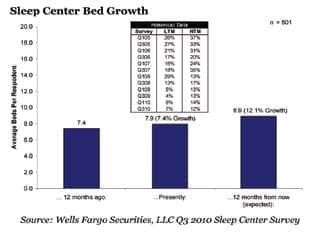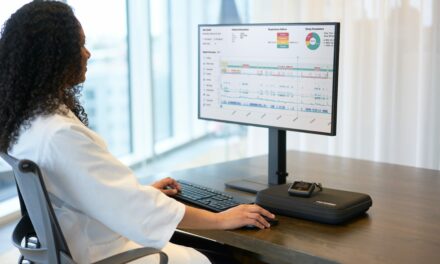The sleep market appears to be following the ebb and flow of the economy at large. Despite wavering reports of economic developments and stock market shifts, the economy at large is said to be stabilizing. Such also has been the trend in the sleep market, according to the Q310 Sleep Center Survey, conducted by Sleep Review in partnership with Wells Fargo Securities, LLC. Sleep centers in the survey report expanding bed capacity by 7% in the last 12 months (LTM), down from 9% in our Q1 2010 survey but up from 1 year ago where centers reported expanding bed capacity by only 4%.

BED GROWTH DURING LAST 12 MONTHS
Bed growth in the last 12 months slowed slightly from our prior survey. Respondents reported bed growth of 7.4% during the last 12 months and indicated an average of 7.9 beds per respondent versus 7.4 beds per respondent 12 months ago. In the Q1 2010 Sleep Center Survey (January 2010), respondents reported growth of 8.7%, and in the Q3 2009 Sleep Center Survey (June 2009), respondents specified growth of 4.1%.
There are a few caveats regarding the results. First, we note that sleep center growth covers only part of the entire sleep market, as sleep center growth drives new diagnoses and flow generator sales, while mask sales are mostly driven by replacement sales. Second, sleep center growth as defined in our survey only represents organic growth (beds per center) versus inorganic growth (new sleep centers). And third, as home testing becomes more prevalent, it is possible that sleep center growth may become less correlated with the overall growth in the sleep market. Finally, we note that many respondents are indicating the total number of beds for multiple sleep centers, which pushes the average number of beds per respondent higher (ie, we doubt that the average individual sleep center has 7+ beds).

Overall, we think that the survey indicates that sleep center growth has stabilized in the high single digits. During 2009, we estimate that flow generators (driven mainly by new patients) grew by 8% to 10% while masks (driven by both new patients and increasing replacement among existing patients) grew by 13% to 15%; combined, this puts the market in the low teens. Looking into 2010, we expect the US CPAP market to grow by 12% to 14% with 7% to 8% volume growth in new patients and 5% to 6% growth from mix shifts toward higher priced products and increased mask replacement rates.
BED GROWTH DURING NEXT 12 MONTHS
Respondents expect greater sleep center capacity expansion in the next 12 months (12.1% to 8.9 beds per respondent) than the growth seen in the last 12 months. However, this is down slightly from our prior survey. In our Q1 2010 survey, respondents expected growth in the next 12 months of 14.1%, and in our Q3 2009 survey, respondents expected growth in the next 12 months of 12.8%. Since our prior surveys have indicated that sleep centers overestimate their projected growth rates by 150% to 200%, we interpret this to mean that sleep center growth is likely to be stable in the upper single digits over the next 12 months.
PATIENT VOLUME GROWTH SLOWED SLIGHTLY
Sleep center volume growth also slowed slightly from our prior survey. On average, respondents have seen patient volume grow 3.4% in the last 12 months and expect 8.7% growth in the next 12 months, and we note that the most common responses were for 0% to 4% growth in both the last 12 months and the next 12 months. These growth rates compare with 4.6% and 9.4%, respectively, in our Q1 2010 survey and 5.7% and 8.8%, respectively, in our Q3 2010 survey. The reported and expected patient volume growth rates are lower than the reported and expected bed growth rates (which were 7.4% and 12.1%, respectively).
We are not sure how to explain the discrepancy between these two questions; one possible explanation might be that there is a lag between sleep center expansion and patient volume growth. This is the seventh time we have asked this particular question, and it appears that there is a clear downward trend in the last 12-month patient volume growth rates. We can think of two reasons that patient volumes are slowing: (1) the sleep market is maturing and penetration is increasing (ie, the “law of large numbers”), and/or (2) home sleep testing is gaining traction and cannibalizing sleep center volumes.
STABILIZATION IN THE ECONOMY LIKELY TO DRIVE PATIENT VOLUME GROWTH

Given the state of the US economy and investor concerns over the economy’s impact on the sleep apnea market and the broader health care industry, we again included several questions about the economy. About a third (36%) of the respondents indicated that the economy has begun to have a positive impact on patient volumes. This is an improvement from 28% in our prior survey. We note that while CPAP is nearly universally covered by Medicare and insurers, patients may have to pay significant deductibles or co-payments “out-of-pocket.”
Looking out over the next 12 months, the sleep centers expect the economy to cause a 1.0% increase in their volume growth. This is a slight improvement from the 0.9% increase that was expected in our Q1 2010 survey. When asked about why patient volumes were being hurt, the most common response (from 65% of sleep centers) was patient concern over out-of-pocket expenses.
HOME TESTING USE ON THE RISE
Currently, 21% of sleep centers offer home sleep apnea testing for Medicare patients and 23% offer home testing for privately insured patients. This is up from 20% and 20%, respectively, in our prior survey. Additionally, another 29% of the sleep centers plan to start to administer home tests in the next 6 months. This is up from 19% in our prior survey.

In another question about how the sleep centers were responding to the threat of home sleep testing, 38% of the respondents indicated that they expect to increase involvement in home testing, which was up from 32% in our prior survey. Putting these two questions together, it seems that the sleep centers are starting to “bite the bullet” and embrace home testing.
ABOUT THE SURVEY
Among the roughly 12,500 sleep professionals that we sent the survey to, 536 responded to one or more of the survey questions for a response rate of 4%. The responses were collected between June 22, 2010, and June 29, 2010. None of the questions in this survey were mandatory, therefore response rates varied from question to question. We received responses from a range of sleep industry participants with sleep center directors/supervisors/managers (37% of respondents) and registered polysomnography technicians (28% of respondents) representing the most common titles. Responses also covered every geographic region and 47 of the 50 US states with the Midwest (29% of respondents) and Southeast (29% of respondents) the most heavily represented regions.




